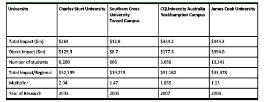Regional universities 'vital' to health of national economy
Published on 03 August, 2009
Any short-term cost savings in concentrating university education into capital cities would be more than offset by negative impacts on regional areas argues John Rolfe ...
The debate about regional universities in Australia is likely to intensify as a part of the challenge to improve higher education in Australia with limited resources. The Australian Review of Higher Education highlights the difficulty that regional universities face in delivering services across regional areas with many campuses smaller than the nominal efficient size of 5,000 students. Recommendations of the review include an increase in regional loadings to help universities deliver services (Recommendation 16) and a feasibility study to establish a national university for regional areas (Recommendation 17). The sub-text behind these recommendations is that the 14 universities in Australia that are involved in regional areas are finding it difficult to offer the same level of services as metropolitan universities given the available funding and differences in student cohorts.
If it is the case that regional universities are too small and expensive to be efficient, then an argument could be mounted that it may be better to concentrate resources in a smaller number of large universities in major urban areas. A focus on cost-effectiveness might suggest this type of rationalisation. However, as noted in the Review, a more comprehensive assessment should consider the additional benefits that are delivered through regional universities, including the important contribution made to regional economies.
Higher education institutions can have a significant impact on regional economies in three main ways. First, universities have income and employment effects on regional areas, locating staff, students and suppliers in regional economies. Second, universities enhance human capital and social capital through education, helping to inject skilled labour into regional areas. Third, the beneficial spillover effects of research and higher human capital generate productivity improvements. Unfortunately, these impacts are often difficult to measure and assess.
There have been a limited number of studies assessing the impact of regional universities on their regional or local economies. These have generally employed economic modelling to assess the more tangible impacts of expenditure and incomes. Effects include the expenditure of universities on staff and services in regional areas, and the retention and attraction of students who then create their own expenditure and income patterns in regional economies. Because the bulk of those staff and students would not otherwise be located in regional centres, regional universities can be expected to have much higher impacts on their economies than corresponding universities in urban settings.
A summary of several studies on the regional economic impacts of universities are summarised in the table below.

The table ... LINK to larger version
Although some differences over time and in the methodologies employed may have some confounding influences, the results allow two important conclusions to be drawn. First, the two whole-university studies of Charles Sturt University and James Cook University indicate similar economic impacts per student of between $32,000 and $34,000. This confirms that regional universities make very large and important direct contributions to their regional economies.
Second, the level of contribution varies significantly according to whether the campus is a satellite or a central hub. In the case of the Tweed campus for Southern CrossUniversity, the economic impacts for this satellite campus are lower. For CQUniversity, where the Rockhampton campus is the hub of several domestic and international campuses, the economic impact per regional student enrolled is much higher. This is because the University, with one of the highest ratios nationally of international to domestic students, is essentially acting as a regional exporter, with subsequent impacts on its local economy.
Evidence about the other beneficial impacts of regional universities can be taken directly from the Bradley review. Approximately 25% of Australia's population can be classified as regional or rural, but university participation from this cohort are currently less than two-thirds of the national average. Regional Universities contribute in two important ways to address this issue. First, universities provide direct access for students in regional and remote areas. The University of Ballarat, CQUniversity and the Batchelor Institute have the highest proportions of students from these areas, in excess of 70% of domestic enrolments. Second, they improve access of students from low socio-economic status, with the Batchelor Institute and CQUniversity having the highest national proportions at more than 45% of domestic enrolments. As students from regional areas and low socio-economic backgrounds are often less familiar with tertiary education, universities servicing these groups need to be specialized in providing the appropriate support and encouragement. Regional universities also contribute to regional areas by providing research and development services, by adding to governance capital, and by improving the image and attractiveness of regional areas. Universities help to hold and attract young people to regional cities, contributing to the social, cultural and sporting fabric of communities, and generating important shifts in future location choices and demographic patterns. In regional centres like Armidale, Ballarat, Toowoomba and Rockhampton, universities employ a significant proportion of skilled professionals in the regional economy, helping to maintain a diversity of skills and experience in regional areas.
This evidence suggests that regional universities contribute large and important benefits to regional economies and communities. Some of the benefits are the direct economic impacts. As well, the contribution to human capital through education maintains economic prospects for regional areas, while the contributions to social capital are important to maintain the vibrancy and attractiveness of regions. This suggests that any short term cost savings in concentrating university education into capital cities would be more than offset by negative impacts on regional areas. These would occur through the loss of direct economic stimulus on regional economies, the increased cost of providing appropriate skilled labour into regional Australia with subsequent impacts on regional industries, and the human costs in terms of reduction in vibrancy, equity and opportunity in regional areas.
Dr John Rolfe is Professor in Regional Development Economics at CQUniversity Australia

